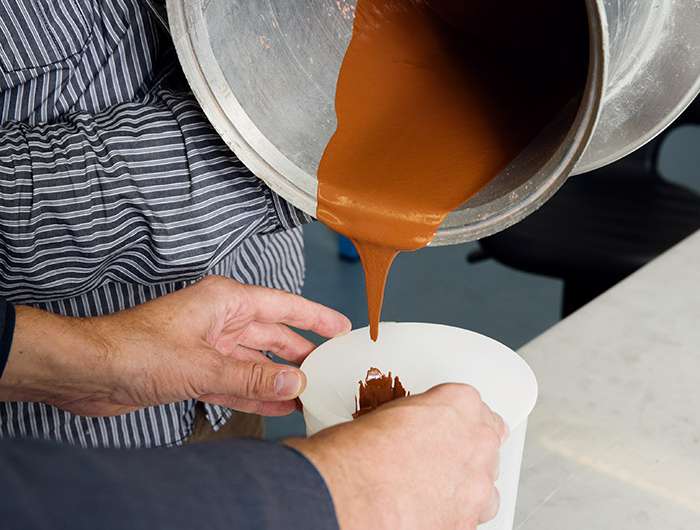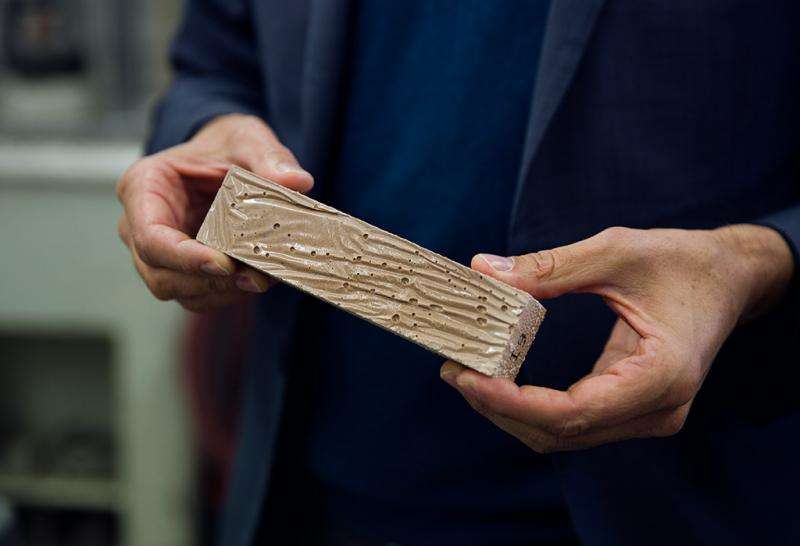Geopolymers as a climate-friendly cement alternative

Researchers at TU Darmstadt are proposing geopolymers as an alternative to cement. These mineral binders are not only more environmentally friendly, they are also more resistant to chemicals and high temperature.
When discussing greenhouse gases, there is usually one aspect that comes off badly: building with concrete is affecting the climate by releasing more carbon dioxide per year than global air traffic. The reason lies in the production of the cement, the most popular binder in the construction industry. Cement is made by grinding and burning limestone, clay and marl.
This requires a lot of energy and also removes the carbon dioxide from the limestone. More than 5% of global carbon dioxide emissions come from cement production. This does not have to be the case, thinks Professor Eddie Koenders, civil engineer and Head of the Institute of Construction and Building Materials at TU Darmstadt. His group is working with geopolymers as a promising alternative to cement.
Geopolymers are two-component systems, comprising of a reactive solid, that contains silicon and aluminium oxide, and a basic activation solution of alkali hydroxides or alkali silicates in water. The solid is a natural stone or mineral, which is why it has the prefix "geo". When the activation solution is mixed with the grinded solid, to which aggregates and other substances belong to, depending on the application, the result will be a rock-hard, anorganic polymer. The molecular components, the monomers, are tetrahedrons with oxygen atoms at the four corners and a silicon or aluminium atom inside.
The term "geopolymer" was launched by the French chemist Joseph Davidovits in the seventies. Thus far, the materials did not made it onto the mass market, but the ongoing climate debate has now given new momentum to geopolymer research. "There is a great international interest," says a delighted Koenders, who together with companies and research scientists from Spain, France, Austria and the UK, is currently formulating an application for an EU project.
The first geopolymers were based on metakaolin, a heat-treated kind of kaolin clay. When heated to about 600 degrees Celsius, kaolin changes its structure, becomes more reactive and sets quickly whenever in contact with the activation solution. The issue is, that the pre-thermal treatment also consumes a lot of energy. But as kaolin does not contain any bounded carbon dioxide that will release during heating, and that the firing temperature is much lower than when burning cement, the carbon footprint is clearly better.
However, metakaolin is an extremely fine material, and working with geopolymers made of it is very different than working with cement paste. They are, for example, thixotropic: when you stir them or shake them, they liquefy – like ketchup, that is initially reluctant to leave the bottle, but then suddenly gushes out. The activation solution also makes the geopolymers somewhat sticky, which is why it is more difficult to remove the formwork.

"Geopolymers will only ever replace concrete and cement on a large scale if they have the same workability", stresses Koenders. His staff, Dr Neven Ukrainczyk and Oliver Vogt, are testing different raw materials, to try to improve the handling. Less pure kaolins, containing iron oxide and other foreign minerals, are proving to be more suitable, as well as being more cost-effective.
Fly ash, a waste product from flue gases, and the natural stone trass are a possible admixture or alternative to metakaolin. The researchers are getting the trass from the Eifel, where it was formed after volcanic eruptions. After excavation, the trass is grinded and can then be used directly. A further advantage is that it is rich in alkalies.
This can reduce the concentration of the alkaline activation solution – which reduces the cost. The research focuses not only on the main components of the geopolymers, but also on finding new admixtures, designed to give the new construction material specific properties. Conventional superplasticizers, for example, that separate binder particles in self-compacting concretes, do not work in geopolymers because of their different chemical composition, and they therefore have to be re-designed.
Vogt and Ukrainczyk are the perfect team to do this, because as a qualified civil engineer, Vogt always keeps an eye on the practical application, while chemical engineer, Ukrainczyk, is an expert for the molecular basis and the physico-chemical analytics. When he joined TU Darmstadt in 2014, Koenders agreed that it might be possible to set up a microlaboratory for examining geopolymers and other construction materials on the micro to nano scale. How much water is needed for a new material to react? What is its molecular structure? How does it behave at different temperatures, such as at minus 60 and at more than 100 degrees Celsius?
A calorimeter, X-ray defractometer, viscometer and other special equipment are available in the micro-laboratory to answer questions like these. The next purchase will be an atmospheric scanning electron microscope, which can examine construction materials at different humidities and temperatures, as well as under mechanical loading. Conventional scanning electron microscopes, of which there are a few at TU Darmstadt, only work in a high vacuum and do not reflect the ambient conditions under which construction materials are used.
Cement is still the most-used construction material in the world, but geopolymers have the potential to contest this ranking when it comes to special applications. Not only does their carbon footprint give them a better performance, they also have technical advantages. Geopolymers are more heat-stable than concrete – the bound water which builds up vapour pressure in the event of a fire, results in spalling or cracking. They are also more resistant to chemicals, as they do not contain hydration products, which dissolve when exposed to acids or other aggressive substances. It is also worth noting that it only takes one day for geopolymers to develop compressive strengths that are similar to high performance concretes.
They can be quickly demoulded, making them suitable for mass production of prefabricated construction elements. The TU Team is currently busy making geopolymer sewer pipes that are resistant to bio-chemicals. Until now, the new construction mate rials are more expensive than conventional cement or concrete, says Koenders, but their durability would justify the higher price. "We are looking for solutions that are also economically interesting. We want to put geopolymers into practice as quickly as possible."
More information: Neven Ukrainczyk et al. Reactive Transport Numerical Model for Durability of Geopolymer Materials, Advances in Chemical Engineering and Science (2016). DOI: 10.4236/aces.2016.64036
Provided by Technische Universitat Darmstadt




















